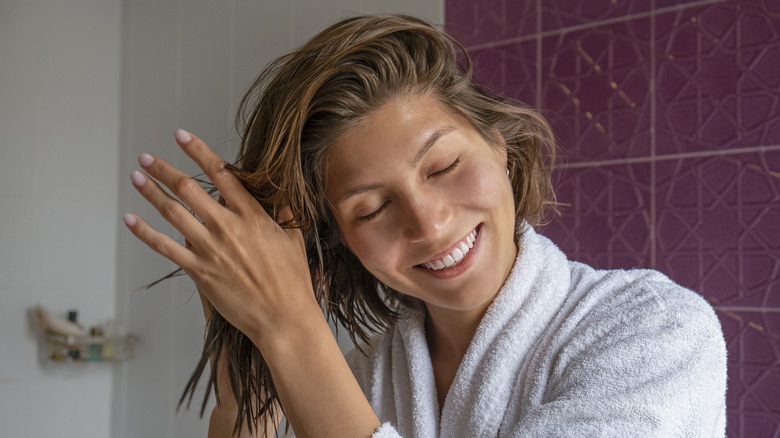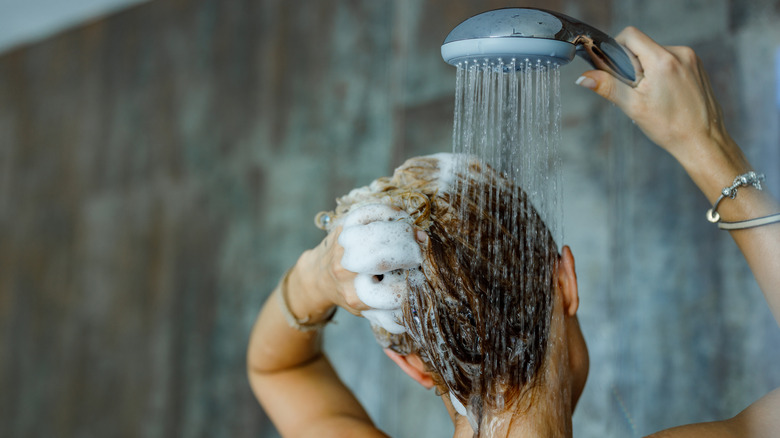Can You Use Leave-In Conditioner Daily? The Answer Is Complicated
Leave-in conditioners are the happy cousins of standard conditioners, and they have revolutionized haircare. If you've delved into the world of conditioners, you may already know what a leave-in conditioner can actually do for your mane. They keep your strands moisturized, protect them from sun damage and other environmental pollutants, strengthen damaged locks, reduce frizz and keep curly and/or thick tresses tame, and make your hair look shiny and revitalized. They also make detangling a breeze, no matter your hair type. What's not to love?
Experts believe that any type of hair can benefit from using a leave-in conditioner. Unlike normal conditioners that you apply and then rinse off, leave-ins are meant to stay on your locks until the next time you have a shower. Now, you might be wondering how much is too much. Is it okay to add leave-in conditioner to your hair strands every time you shower? What about daily? The answer might be a little more complicated than you think.
How often you use leave-ins depends on a number of factors: your hair type, how often you wash your tresses, what's in the ingredient list, and what the product label tells you to do.
If you wash your hair every day, it's probably okay to use a leave-in daily
Washing your hair daily can strip it of moisture, and this is where leave-ins can come in and work their magic. If you're someone who washes your tresses frequently — every day or every other day for example — it's fine to use a leave-in conditioner with every wash, but make sure that you read the product label first. Most leave-ins come with advice on the bottle about frequency of use. While most are meant to be used with every wash, some heavy-duty options aren't. So read the instructions carefully before applying them.
With frequent hair washing, you're also eliminating the problem of allowing the leave-in product to sit on your tresses and collect gunk for too long a period of time, which is another reason why it's okay to add a leave-in conditioner to your haircare routine if you shampoo daily. Alternatively, if you only wash your tresses once a week, it might not be the best idea to include a leave-in conditioner in your bath time ritual. The last thing you want is oily, limp, and lifeless-looking tresses caused by naturally oily hair and a leave-in that sits on your locks and causes excess buildup.
But this might not be a problem if your hair is particularly dry. One of the best ways to understand the correct frequency for your particular hair type is through experimentation.
Your hair will tell you if daily use is a bad idea
As long as the bottle on your leave-in doesn't forbid daily use, an uncomplicated way to figure out frequency is to test the product out on your hair and see how your locks look and feel. Begin with daily application — after shampooing, conditioning, and rinsing — and do this for the next few days. If your hair looks and feels nourished and healthy, then you don't have to worry about daily use. If not, you may want to cut back. Limp or overly oily hair between washes is usually a sign of too much product buildup.
Dry and damaged hair from color treatment and heating tools or particularly frizzy curls could benefit from daily leave-in conditioner use too, but again, your hair will tell you if this is accurate or not. Apply the product to damp hair strands starting from the middle and going down. Avoid the scalp or roots.
The ingredient list is another clue. While you should be looking for natural and/or organic ingredients like natural oils (think jojoba and grape seed), vitamins, antioxidants, water, proteins, and botanical extracts (aloe vera, essential oils, etc.) that act as heat protectants, generally, light formulas are better suited for regular applications. And of course, do some research and find the best leave-in conditioners for everyday use. Ultimately, your haircare regimen will be different from that of your friends or family members. The trick is to find out what works for you.

